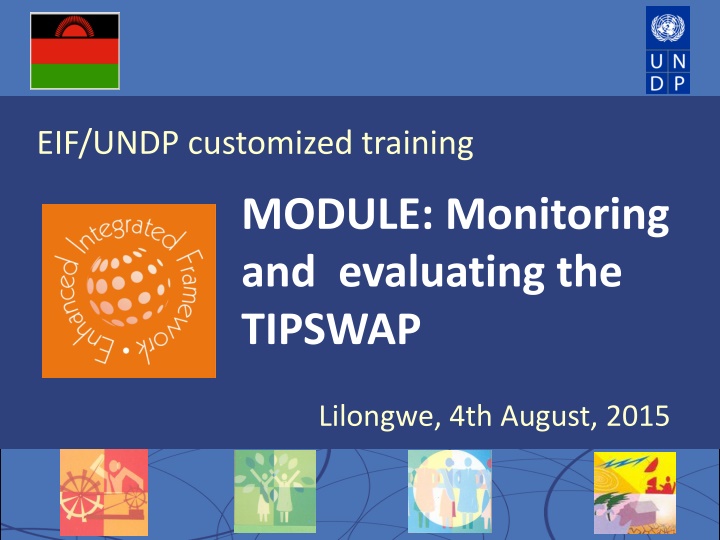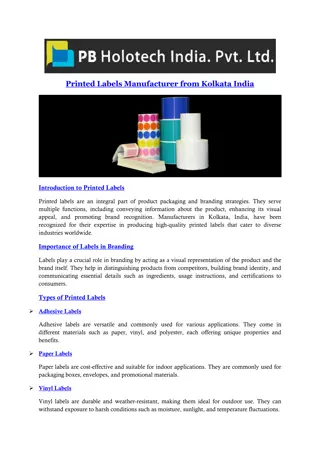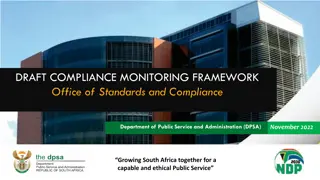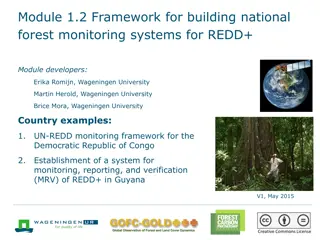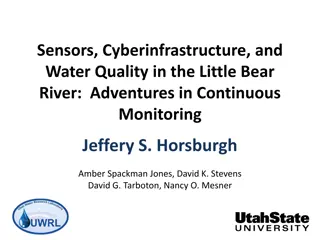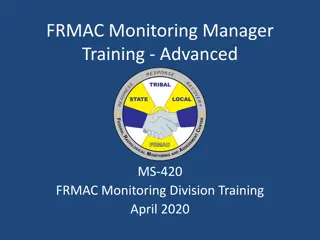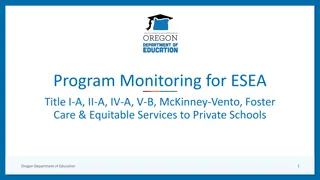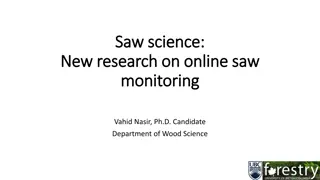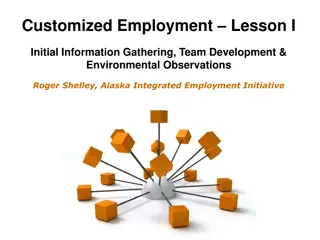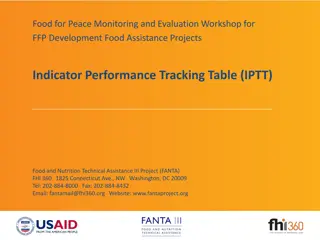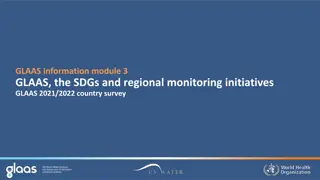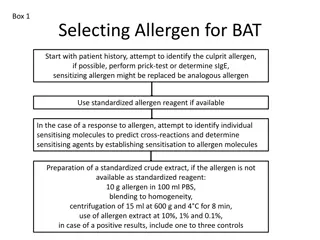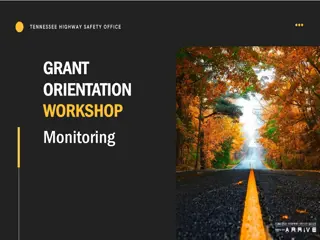Customized Training on Monitoring and Evaluating TIPSWAP
Participants in this training are exposed to key concepts and lessons learned on monitoring and evaluation for sector-wide approaches, focusing on enhancing the M&E of TIPSWAP. The training covers various topics such as policy cycle, defining TIPSWAP, and measuring results. Through sessions and group work, participants gain insights on designing and utilizing M&E strategies effectively.
Download Presentation

Please find below an Image/Link to download the presentation.
The content on the website is provided AS IS for your information and personal use only. It may not be sold, licensed, or shared on other websites without obtaining consent from the author.If you encounter any issues during the download, it is possible that the publisher has removed the file from their server.
You are allowed to download the files provided on this website for personal or commercial use, subject to the condition that they are used lawfully. All files are the property of their respective owners.
The content on the website is provided AS IS for your information and personal use only. It may not be sold, licensed, or shared on other websites without obtaining consent from the author.
E N D
Presentation Transcript
EIF/UNDP customized training MODULE: Monitoring and evaluating the TIPSWAP Lilongwe, 4th August, 2015
LEARNING OBJECTIVE Participants are exposed to key concepts, experiences and lessons learned on monitoring and evaluation (M&E) for sector wide approaches. Options for enhancing the TIPSWAP M&E are identified, discussed and analyzed.
Module 1: outline SESSION 1 Introduction to M&E (Why? What? How?) Key concepts, results chain and lessons learned SESSION 2 M&E function in the TIPSWAP SESSION 3 Group work: designing and using M&E
SESSION 1 KEY CONCEPTS
For whom? TIPSWAP Definition All significant funding for the sector supports a single sector policy and expenditure programme, under government leadership, adopting common approaches across the sector, and progressing towards Government procedures to disburse and account for all funds. (Foster, 2009)
For whom? TIPSWAP A new way of implementing policies and coordinating trade-related assistance All significant funding agencies support a shared, sector wide policy and strategy the JSP A medium term expenditure framework or budget which supports this policy (?) Government leadership in a sustained partnership (?) Shared processes and approaches for implementing and managing the sector s strategy and plan - YES Commitment to greater reliance on Government financial management and accountability systems (?)
Why? Focus on results vs. activities Guarantee transparency and accountability Measure and communicate results Enhance strategic focus of a strategy/plan Get more funds!
What? measuring results Results are changes in a state or condition that derive from a cause-and-effect relationship. There are three types of such changes (intended or unintended, positive and/or negative) that can be set in motion by a development intervention outputs, outcomes and impacts. UNDG agreed RBM terminology
Results-Based M&E PLANNING INPUTS OUTPUTS IMPACTS OUTCOMES What we will see in lives of people in long-term What capacities we help develop What results we help achieve What we invest What we do IMPLEMENTATION
GOAL (or IMPACT) The higher-order national objective to which a development intervention is intended to contribute. It can be described as the positive long-term effects on identifiable population groups produced by a development intervention. Malawi: double exports and economic diversification by 2019 Source: JSP
OUTCOME Actual or intended changes in development conditions that interventions are seeking to support. Oil seeds: Increased production through more efficient farming and higher yields and more irrigated oil seed produce. Increased quality of produce. Increased exports due to increased ease of exporting as regulations are more transparent
Outcome: typical pitfalls Wordy (..and no change language) Too ambitious Containing multiple results Wishy-washy (Support provided to improve..) So general, they could mean anything Overlapping with other goals Confusing means and ends 13
OUTPUT Deliverables/end-results, e.g. new skills or abilities, new products and services. They must be achieved within the target period by a responsible entity that has a high degree of control in delivering. Oil seeds: market linkages improved between seed producers and irrigation farmers
Output: typical pitfalls Wordy Unclear logic and confused indicators Over-ambitious Passive voice and wishy-washy (i.e. Support provided to improve) Overlapping with outcomes or repeating activities
SESSION 1 HOW TO DESIGN AN M&E FRAMEWORK
What is M&E framework? 1. Prioritize results (what results to measure) 2. Refine results (outcomes and outputs, when needed) and hold entities accountable (assign responsibilities for outcomes and outputs, when unclear) 3. Develop the reporting tool (How you will measure/document results in an excel table) 4. Measure results (who will populate the excel table)
STEP 1: prioritization JSP has currently 1 goal, 13 outcomes and 34 outputs. Start small and where it is easier to achieve and measure results, e.g. oil seeds. In the 1st year SWG to prioritize 5 outcomes and develop an M&E framework for those. Learn from the process. Then expand. Don t let us/consultants do it all for you. It rarely works!
STEP 1: prioritization, cont. Four criteria: 1. Clarity and consensus on outcomes and outputs 2. Potential to achieve measurable results by 2018 3. Seed resources available for programming 4. Commitment of responsible entities and partners
STEP 2: results & responsibilities For the 5 prioritized outcomes, make sure that outcomes and outputs are properly formulated, clearly understood and there is sufficient consensus on implementation If not, arrive at a consensus in the TWG on what needs to be done and by whom At the end of the process, make sure there is a clear identification of responsible parties SWG to endorse any change to the JSP
STEP 3: reporting tool LINK TO EXCEL FILE
STEP 4: M&E responsibilities Who is responsible for 1. Designing the reporting tool (i.e. indicators, baselines and targets)? 2. Validating and endorsing the reporting tool? 3. Collecting data and compiling quarterly monitoring reports? 4. Validating and endorsing the monitoring reports? 5. Commissioning independent evaluations? 6. Communicating results?
SESSION 1 HOW TO DESIGN THE REPORTING TOOL
Indicators Indicators describe how intended results will be measured - accountability Objectively verifiable, repeatable measures of a particular condition They force clarification of what is meant by the result .the fine print! Must be accompanied by baselines and targets Max 2 indicators per outcome fewer the better 1 indicator per output is sufficient For each outcome add 1 sustainability indicator to control for social and/or environmental impact
Baseline, Target and Results Performance Target Results at end of period Planned level of achievement INDICATOR Current level of achievement
What are SMART indicators? SPECIFIC Is the indicator specific (i.e. quality, time, target groups, baseline)? MEASURABLE Will the indicator show desirable change? Is it a reliable and clear measure of results? Is it too sensitive to changes in policies and programmes? Do stakeholders understand/agree on exactly what to measure? ACHIEVABLE Are the result(s) realistic and based on risk assessment, and other factors? RELEVANT Is it relevant to the intended result? Does it reflect expectations and success criteria? TRACKABLE Are data actually available at reasonable cost and effort? Can proxy indicators be used? Are data sources known?
Types of indicators Factual indicators Policy recommendation submitted Law passed by Parliament Chamber of Commerce established Existence of automated customs: automated, partly, not automated Factual (yes/no) Existence (yes/no) Classes (x/y/z) Numeric indicators No. of government officials trained No. of networks on trade related-subjects created No. of CSOs attending conference on trade % of government budget devoted to trade sector % of enterprises with access to single window Ratio of jobs created by exporting SMEs Number Percentage Ratio
Indirect (Proxy) Indicators Purpose Direct indicator Proxy indicator as substitute Quality of customs improved -> difficult and expensive to pass the border Number of days required to export/import a container to XX Number of documents to be processed electronically Improvements in customs administration household income - > household income survey needed -> not frequent enough Changes in local retail sales Increase in the total number of cell phone users in the state Increase in per capita income in the poorest state Crop sales and food consumption -> survey needed -> too expensive Purchase of typical consumer items Improvement in buildings (e.g. roof) of life style (consumption of meat per week) To increase per capita income of small farmers
Outcome indicators: sugar Increase the scale in production and milling of sugar cane 1. Total production of raw sugar cane (volume) 2. Total production of refined sugar (volume) 3. Average yields 4. Cost of production per ton of refined sugar Improve quality and pricing 1. Price per ton (note: assumption no major fluctuation in international prices) 2. Number of private sector and government labs accredited by internationally recognized bodies High value processing 1. Number of HS 6-digits lines where Malawi records exports (Sugar and Sugar Confectionery) 2. Percentage of Sugar Confectionary exports over Raw sugar exports
Output indicators Government staff have improved trade analysis skills 1. Number of staff trained by end 2013 2. % of staff trained that were rated as more effective in doing their jobs 1 year later 1. Number of copies of study distributed 2. Percentage of Parliamentarians who receive copy 3. Extent to which findings of the study were used to inform high-level policy discussions and decisions 4. Extent to which findings have influenced major initiatives or budget allocation 1. Number of staff completing training in quality standards by end 2013 2. % of staff who believe they are more effective in undertaking their tasks after they received training Quality of study produced, and used to inform public policy Government and private Sector organizations in xx districts have resources and skills to improve quality standards Draft trade policy formulated and submitted to Cabinet 1. Progress made in drafting new policy 2. Stakeholder satisfaction with quality of draft new policy
Sustainability indicators Objective: check for social/environmental impact Goal: Maximize the potential growth sectors fostering job creation; empowering rural communities; ensuring equitable access to land; and promoting sustainable use of the environment. (MSDG II) Goal level headcount poverty in rural areas Outcome level number of jobs (e.g. in oil seeds or sugars) rate of deforestation or re-forestation number of fair trade / organic certification measure of soil degradation
Input Activity Output Outcome Impact Sector-specific expertise in disaster preparedness developed Income of low-income families increased To train community members in customs management By 2013, livelihoods of agriculture dwellers are more secure International consultants to conduct study Capacities created for an extended response to food security emergencies New businesses and jobs are created in targeted, poor rural areas Study tour National and local policies and plans are responsive to gender issues By 2016, SMEs growth rate rate is above 10 percent Low-income families acquired the skills necessary to sustain micro-enterprises in export sectors Policy and regulatory environment improved for small enterprises Pro-poor trade policies drafted
Input Activity Output Outcome Goal Sector-specific expertise in disaster preparedness developed Income of low-income families increased To train community members in customs management By 2013, livelihoods of agriculture dwellers are more secure International consultants to conduct study Capacities created for an extended response to food security emergencies New businesses and jobs are created in targeted, poor rural areas Study tour National and local policies and plans are responsive to gender issues By 2016, SMEs growth rate rate is above 10 percent Low-income families acquired the skills necessary to sustain micro-enterprises in export sectors Policy and regulatory environment improved for small enterprises Pro-poor trade policies drafted
SESSION 2 UPDATE FROM THE MINISTRY OF INDUSTRY AND TRADE
SESSION 3 GROUP WORK
GROUP WORK Objective: develop draft indicators for the JSP Type of engagement: group brainstorming Tasks: 1. Select 2 outcomes of the JSP (15 minutes) 2. For each outcome propose 2 outcome indicators 3. Select 1 outcome and propose 1 indicator per output 4. For the outcome selected propose 1 sustainability indicator
